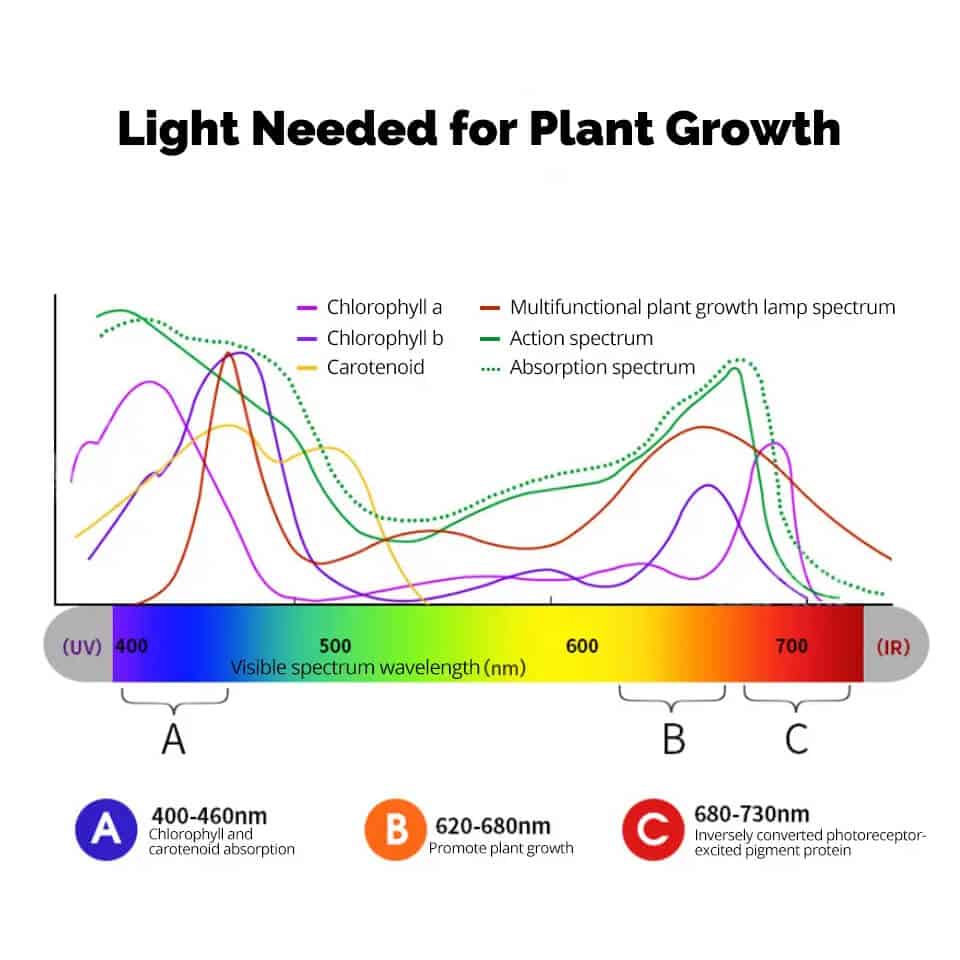Plants have a different sensitivity to the spectrum than the human eye. The most sensitive spectrum of the human eye is 555nm, which is between yellow and green light. It is less sensitive to blue light and red light. Plants, on the other hand, are most sensitive to the red light spectrum and less sensitive to green light, but the difference in sensitivity is not as wide as the human eye. Plants are most sensitive to the spectrum at 400-700nm. This region of the spectrum is often referred to as the photosynthetically effective energy region. About 45% of sunlight’s energy is in this part of the spectrum. Therefore, if artificial light sources are used to supplement the amount of light, the spectral distribution of the light sources should also be close to this range.

The energy of photons emitted by a light source varies by wavelength. For example, the energy of wavelength 400nm (blue light) is 1.75 times the energy of 700nm (red light). But for photosynthesis, the effect of the two wavelengths is the same. The excess of the blue spectrum that cannot be used as energy for photosynthesis is turned into heat. In other words, the photosynthesis rate of plants is determined by the number of photons absorbed by plants in the 400-700nm range, and is not related to the number of photons emitted by each spectrum. But the common sense of people thinks that the color of light affects the rate of photosynthesis. Plants have different sensitivities across all spectrums. The reason for this comes from the special absorption of pigments in leaves. Among them, chlorophyll is the most well-known. But chlorophyll isn’t the only useful pigment for photosynthesis. Other pigments are also involved in photosynthesis, so the photosynthesis efficiency cannot be considered only by the absorption spectrum of chlorophyll.
The dissimilarity of photosynthesis pathways is also not related to color. Light energy is absorbed by chlorophyll and carotene in leaves. Energy is converted into glucose and oxygen by two photosynthetic systems to fix water and carbon dioxide. This process utilizes the entire spectrum of visible light, so light sources of various colors have little difference in their effect on photosynthesis.
Some researchers believe that the most photosynthetic capacity occurs in the orange-red light part. However, this does not mean that plants should be cultivated under such monochromatic light sources. Plants should receive a variety of balanced light sources for their morphological development and leaf color.
Blue light source (400-500nm) is very important for plant differentiation and stomatal regulation. If the blue light is insufficient and the proportion of far-red light is too much, the stem will grow excessively, which will easily cause the leaves to turn yellow. The ratio of the energy of the red light spectrum (655~665nm) to the energy of the far-red light spectrum (725~735nm) is between 1.0 and 1.2, and the development of the plant will be positive growth. But each plant has a different sensitivity to these spectral ratios.
High pressure sodium lamps are often used as artificial light sources inside greenhouses. Taking the Philips Master SON-TPIA light source as an example, it has the highest energy in the orange-red spectral region. However, the energy of far-infrared light is not high, so the red/far-red energy ratio is greater than 2.0. But because the greenhouse still has natural sunlight, it did not cause the plants to become shorter. (If this light source is used in a growth chamber, it may have an effect.
In natural sunlight, blue light energy occupies 20%. For artificial light sources, such a high ratio is not required. For normally developing plants, most plants require only 6% of the blue light energy in the 400-700nm range. In natural sunlight, there is enough blue light energy. Therefore, artificial light sources do not need to supplement more blue light spectrum. However, when the natural light source is insufficient (such as winter), the artificial light source needs to increase the blue light energy, otherwise the blue light source will become a limiting factor for plant growth.
